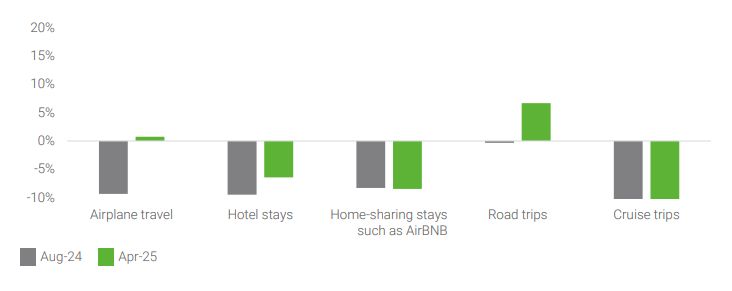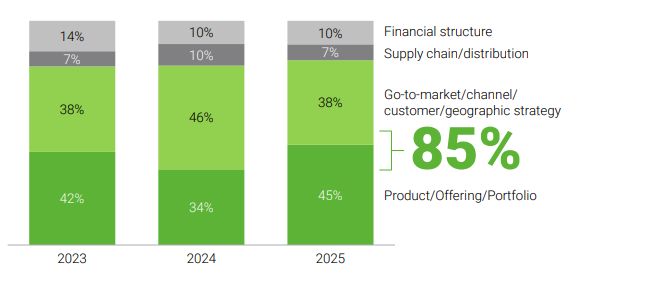- within Consumer Protection topic(s)
- in United States
- within Antitrust/Competition Law and Intellectual Property topic(s)
- with readers working within the Retail & Leisure industries
At a glance
Across the board, restaurants and hospitality companies face greater scrutiny from consumers over whether they want to spend their money. More than 4 in 10 consumers say they feel significant financial anxiety. Shifting lifestyles are influencing how often they travel and dine out.
While a third of consumers say they are reducing restaurant spending due to financial constraints, nearly 70% report cutting back for other reasons. Many feel the quality of food isn't there for the price. Some are happy to pay more despite a tight budget to get the experience they desire, cutting back on frequency even when they aren't trading down.
While travelers are also cutting back on the frequency of trips, they continue to value quality and comfort when they do spend, fueling strong performance in the luxury segment. High-end hotel groups such as Four Seasons and Aman are seeing robust demand, while budget and midscale properties—often reliant on cost-conscious leisure guests and business travel—face more uneven results.

This bifurcation underscores a broader trend: consumers are prioritizing experiences over goods, with a clear preference for premium stays and memorable meals, even as overall travel and dining volumes soften.
To adapt, brands are leaning on menu innovation, sharpened value platforms, digital engagement, third-party delivery, and refreshed service models. Investments in staff—whether through training, scheduling, or added support—are also proving critical, as stronger service can enhance guest satisfaction and reinforce overall value.
While challenges remain, recent earnings illustrate that those who evolve quickly—balancing value, experience, and operational discipline—are well-positioned to capture loyalty and growth in a shifting landscape.
At the same time, cost pressures from commodities and labor remain significant. Margins are thin, and the future state of the consumer is opaque. Operators have their work cut out for them.
Seven in 10 operators report high disruption since 2023 and worry about inflation and regulatory or policy changes in the near-term, but many are concerned they cannot adapt fast enough, primarily due to uncertain or volatile consumer demand, existing business challenges, and a lack of human capital.
Restaurants are the top target for discretionary cutbacks

The consumer is only willing to spend more for a "worth-it" experience. A lack of perceived value is both a reason to ditch a night out, and an opportunity for operators who can deliver a meaningful experience to customers. As it stands, travel seems more inured to cutbacks than retail, leisure, and restaurant spending.
Of course, customer touchpoints—service— come down to talent, 33% of whom reported that "insufficient staffing and a large workload" was a significant problem in 2025, a jump of 18 percentage points. On the upside though, 79% of workers see equal opportunity for career advancement at their company.
The underlying story is one of a shift: operators know they need to innovate around service and their value proposition, while consumers don't want to trade down; they want to save their money for an experience that really counts.
Here we highlight key dynamics from our operator, worker, and consumer surveys, and look at what the industry needs to do in response.
Consumer insights
Financial anxiety is at a record high, with 42% of consumers saying they are "very" or "extremely" worried about their financial health. The number one tactic for reducing debt load? Cutting experiential spending.
Retail, for example, has held up better in 2025 when consumers who intended to cut back were asked which discretionary sectors they would target, and grocery spending is a non-negotiable for two-thirds of respondents. Travel also fared well, with just 34% of cost-cutters intending to snip spending, while restaurants were the top target.
While consumers are reducing restaurant spending due to financial constraints, it's not just about debt. Nearly 70% report cutting back for other reasons: lack of value and a preference for home cooking are top motives—the consumer price index for food at home rose 2.2% year-over-year in July, while that for food away from home increased by 3.9%. No wonder then that 40% of respondents said they could make better food in their own kitchen.
49%
Of consumers deem price is now too expensive for the value offered at restaurants
Consumers who are very or extremely concerned regarding financial health

This has hurt limited-service operators. Even typically strong performers such as Chipotle (comparable restaurant sales down 4% year-over-year in the second quarter) and Wingstop (1.9% YOY decline in domestic same store sales) have not been immune to the challenges of consumer behavior, cited by Wingstop CEO Michael Skipworth as "concerns about elevated prices, future job prospects and general anxiety about the future."
On the other hand, there are bright spots in the casual dining space, with Chili's figuring out the recipe for value and experience. As CEO Kevin Hochman recently said in an earnings call, "It is very difficult for [competitors] to replicate the total value proposition given the amount of time and investment we have put into improving the experience."
The overall trend toward prioritizing experiences has not changed: while debt loads are greater, a higher share of consumers say that reducing dining visits is a top strategy (78%, up from 75% in 2024) while eating at cheaper restaurants continues to be one of the least-attractive strategies (cited by 32%, down from 36% last year).
Aside from the wallet crunch, we see a gap between consumer desire for a worthwhile dining experience and the value they receive. Post-pandemic, restaurants are competing with at-home meals and battling the effects of high inflation and price pass-through on consumer sentiment. Tellingly, fine-dining and coffee-focused restaurants score highest on perceived value, suggesting that cheaper or faster aren't what wins over today's consumer.
Nearly 80% of consumers say restaurant brands can entice them to increase visits. They say they are most susceptible to better food quality (the top tactic, cited by 57%) and better menu pricing (cited by just over half). Menu engineering is now the top recommendation for operators to thwart rising cost pressures in lieu of passing on pricing to consumers.
The analog for travel versus the pandemic-tested "staycation" is more protective of hotel services, which some consumers equate with wellness, but again, there is a focus on quality of experience. Our 2025 Global Consumer Outlook found that younger consumers were ready to spend more (if on a smaller budget), while 31% of highincome consumers expected to increase their spending in 2025, particularly on travel and leisure.
The catch is that premium experiences can't be merely premium-ish. They need to deliver the goods.
Consumers are more interested in traveling, especially air and road travel
Net more interest change this year vs. last year

Operator insights
Nine in 10 operators expect to shift their business model over the next three years, led by product or portfolio, but only half believe their current pace of change is fast enough to achieve their goals—a decline from prior years.
The wider macroeconomic turbulence is crystallized in uncertainty over consumer demand six or twelve months from now. "Falling, volatile, or uncertain consumer demand" was the most commonly stated obstacle to business change, felt by 42% of respondents. Around 85% of operators think their company should invest more time and resources in product offering and go-to-market strategy, but those changes are difficult when you don't know what people's appetite will be.
Companies know what they need to adapt... but change is slow

Top three obstacles to business model change

To view the full article click here
The content of this article is intended to provide a general guide to the subject matter. Specialist advice should be sought about your specific circumstances.
[View Source]




